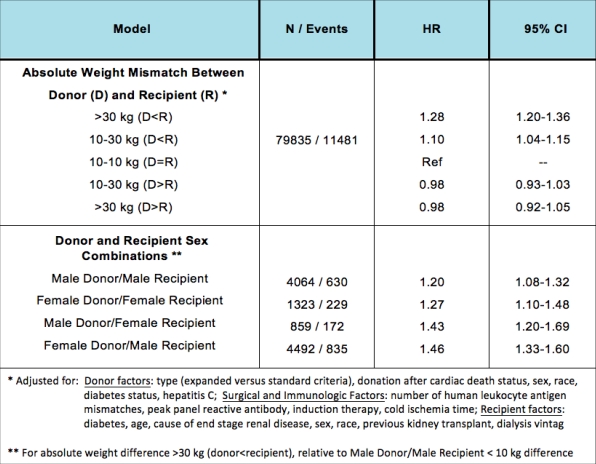Donor-Recipient Absolute Weight Mismatch and the Risk of Graft Loss in Renal Transplantation.
1Medicine, Division of Nephrology, Dalhousie University, Halifax, NS, Canada
2Surgery, Multi Organ Transplant Program, Dalhousie University, Halifax, NS, Canada.
Meeting: 2016 American Transplant Congress
Abstract number: 45
Keywords: Allocation, Donation, Graft survival, Weight
Session Information
Session Name: Concurrent Session: Kidney Transplantation: Outcomes, Matching and Marginal Donors
Session Type: Concurrent Session
Date: Sunday, June 12, 2016
Session Time: 2:30pm-4:00pm
 Presentation Time: 3:18pm-3:30pm
Presentation Time: 3:18pm-3:30pm
Location: Ballroom B
Background: Relatively smaller kidney donor to recipient size is proposed to result in increased graft loss due to nephron underdosing and hyperfiltration injury but few studies have investigated the outcomes associated with donor-recipient body weight mismatching. The purpose of this study was to determine if donor and recipient absolute weight mismatch was associated with graft loss in a cohort of deceased donor kidney transplant recipients.
Methods: We analyzed a cohort of United States deceased donor kidney transplant recipients in the Scientific Registry of Transplant Recipients (2004-2013). Absolute weight differences between donor and recipient were categorized as >30 kg, 10-30 kg, or <10 kg ("no weight difference"). The effect of sex mismatch between donor and recipient was assessed at each strata of absolute weight mismatch. Time to death-censored graft loss was evaluated using multivariable Cox Proportional Hazards models adjusting for known literature predictors of graft loss.
Results: 12,931 of 88,373 kidney transplant recipients developed graft failure, (median follow-up 3.1 years, IQR 1.5 to 5.8 years). After multivariable adjustment for donor, immunological, surgical and recipient factors, a weight difference of >30 kg (donor<recipient) was associated with an increased risk of graft loss relative to no weight difference (HR 1.27, 95% CI 1.20-1.36, table 1). Relative hazards were higher in the setting of concurrent sex mismatch (HR 1.43, 95% CI 1.20-1.69 in female recipients of male kidneys and 1.46, 95% CI 1.33-1.60 in male recipients of female kidneys, table 1).
Table 1: Graft loss stratified by absolute weight difference between donor and recipient

Conclusions: Absolute weight mismatch (donor<recipient) is associated with an increased risk of graft loss among deceased donor transplant recipients. The risk appears highest with concurrent sex mismatch between donor and recipient. This knowledge may better inform the selection of deceased donor kidney transplant recipients.
CITATION INFORMATION: Miller A, Kiberd B, Alwayn I, Tennankore K. Donor-Recipient Absolute Weight Mismatch and the Risk of Graft Loss in Renal Transplantation. Am J Transplant. 2016;16 (suppl 3).
To cite this abstract in AMA style:
Miller A, Kiberd B, Alwayn I, Tennankore K. Donor-Recipient Absolute Weight Mismatch and the Risk of Graft Loss in Renal Transplantation. [abstract]. Am J Transplant. 2016; 16 (suppl 3). https://atcmeetingabstracts.com/abstract/donor-recipient-absolute-weight-mismatch-and-the-risk-of-graft-loss-in-renal-transplantation/. Accessed December 15, 2025.« Back to 2016 American Transplant Congress
